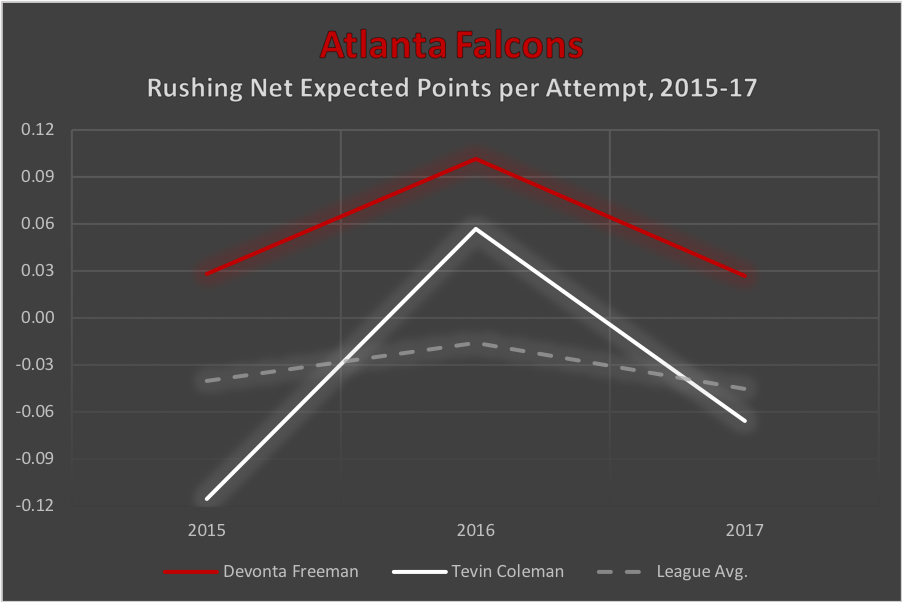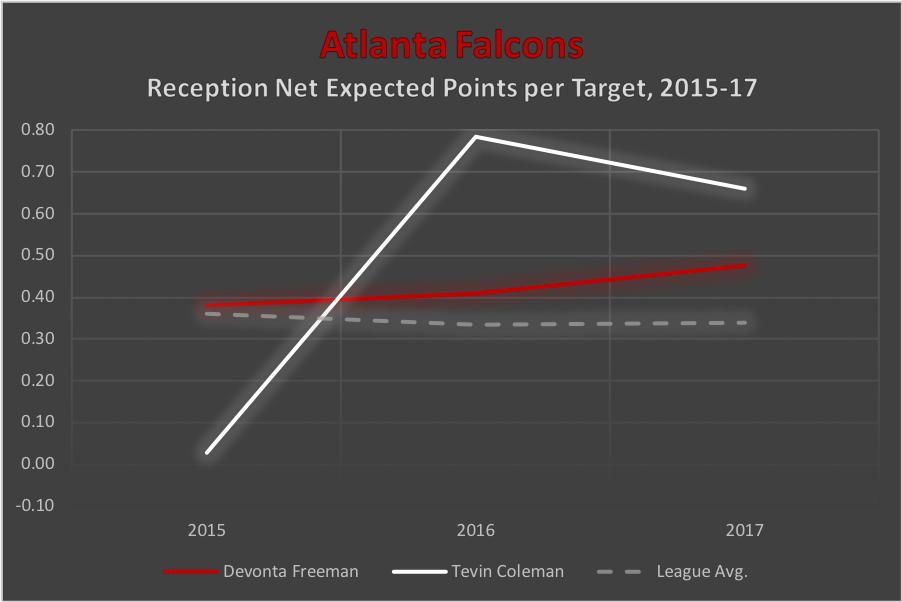Dynasty Fantasy Football: Buy Tevin Coleman Before It's Too Late

Unlike any we've seen in recent memory, the 2015 NFL Draft class was a stacked one for high-caliber running backs.
In fact, according to Pro Football Reference, no running back drafted in the first three rounds of that draft class has failed to produce an Approximate Value (AV, a single number put on a player's career so as to compare values across seasons and/or positions) of 10 or better so far in their relatively young careers. The only other such class since the 1970 AFL-NFL merger was 2008’s stacked group featuring Matt Forte, Chris Johnson, and Jamaal Charles.
Clearly, the class of '15 is proving to be in good company.
Still, one of those running backs stands out from the rest, not because he is or will be better than the others, but because he could soon take the next step from good to great. That's the Atlanta Falcons' Tevin Coleman.
Heading into his fourth season, Coleman's rookie contract will expire after 2018, and he’ll go from change-of-pace back to potential NFL starter. Here’s why he’s worth acquiring in your dynasty and keeper leagues right now.
Running Hot
It's tough to argue that the Falcons have made a mistake keeping Coleman as the “1B†back in their offense when Devonta Freeman has been so impressive over his career.
We can see just how effective the two have been as a tandem by looking at their production in numberFire’s signature analytic, Net Expected Points (NEP). NEP is a metric that describes the contribution a play (or player) makes to their team’s chances of scoring. By adding down-and-distance value to the box score production, we can see just how much each play and each team as a whole influence the outcome of games. For more info on NEP, check out our glossary.
The chart below shows the year-to-year Rushing NEP per Carry that these two backs have been able to produce since Coleman was drafted, as well as the league average rate (gray dashed line). You’ll notice Freeman’s consistency is absolutely unmatched by Coleman, despite a 2016 season that saw a major uptick in Coleman's value.

Where Coleman has proven his immense worth, however, is in his versatility for the Falcons’ offense. Over his 90 career receiving targets, Coleman has returned 57.41 Reception NEP. Freeman has earned 85.77 Reception NEP over the last three years, though it’s taken him more than double the passing looks to get to that point. The chart below shows the two’s yearly Reception NEP per Target rates since Coleman entered the league.

Coleman had a slow start out of the backfield in his rookie year, but since then he’s been a nightmare for opposing defenders. The low-to-the-ground, 5-foot-11 and 205-pound menace rips off catch-and-runs like it’s nobody’s business.
It’s this kind of insane receiving ability, coupled with his explosive big-play upside (17 of Coleman’s 156 attempts went for 1.00 Net Expected Points or more in 2017; 10.9%) that makes Coleman a compelling fantasy asset in his own right.
Big Time
Still, if he earns a full-time gig after he hits free agency in the 2019 offseason, he could be the next big thing. After all, he’s proven he can be a bell cow before.
The table below illustrates how Coleman’s per-game production has changed when separating his games paired with Devonta Freeman versus when Freeman has been inactive (aka when he's been the lead back). How does he do when given the starter’s mantle?
| Coleman (2015-17) | With Freeman | Without Freeman |
|---|---|---|
| Games | 37 | 3 |
| PPR Points | 9.8 | 15.2 |
| Rush Attempts | 8.2 | 19.0 |
| Rush Yards per Attempt | 4.2 | 4.4 |
| Rush TD Rate | 3.6% | 5.3% |
| Targets | 2.3 | 1.3 |
| Catch Rate | 68.5% | 24.8% |
| Rec Yards per Attempt | 12.2 | 15.2 |
| Rec TD Rate | 10.1% | 0.0% |
Astoundingly, Coleman seamlessly morphs from a scatback receiving specialist into a true workhorse-type running back when going solo. In the three games Coleman has played without Freeman in his career, his per-game touches increased by about 100 percent, and his rushing touchdown rate improved by 44.2 percent versus the rest of his career. His per-game targets dropped by more than 40 percent, however, while his rushing attempts skyrocketed by over 130 percent.
However he got there, though, his PPR fantasy points increased by 55 percent -- to 19.0 points per game -- when he was the unquestioned number-one running back. At a full-season pace, the 304 fantasy points we’re attributing to Coleman would have put him behind only Todd Gurley, Le'Veon Bell, and Alvin Kamara among all backs.
Next-Level
It’s not as though complementary backs haven’t been able to make the leap to full-time status in the past.
Lamar Miller is one recent example, and while his per-play efficiency suffered once given a significant amount of touches, he has still been a very viable fantasy running back. In fact, by our preseason projections, Miller comes in as our 19th-best running back -- a low-end fantasy RB2 -- for the 2018 season. Heck, we believe Jerick McKinnon has a shot to become a true fantasy stud in his promotion this year with the 49ers. Coleman could certainly struggle in his first taste of being a team’s real top backfield weapon, but his track record so far shows that he may be up to the task in 2019.
Coleman should be a reasonable fantasy producer this season as a backup, but he has the talent to become a true top-tier running back once he gets a starter’s opportunity. If and when he does, he could be as coveted a dynasty -- or even keeper -- asset as David Johnson, Todd Gurley, or his other peers from the loaded 2015 NFL Draft class.
Don't miss the boat on Coleman before it's too late.
















